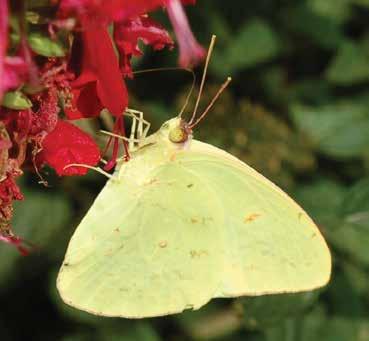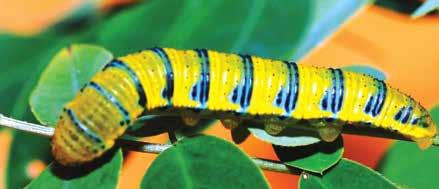
8 minute read
Rose Report
Rose Report Understanding Japanese Beetles, the life cycle, and control options
One of the most frequent questions I get about roses is how do I control the Japanese beetles.
First and foremost I would say do not put up a Japanese beetle trap. This will attract more beetles to your garden.
Understanding the life cycle
To understand how to effectively control the beetle a basic understanding of the life cycle is needed.
The adult beetles that you see in the garden will live for about two months and in our area that is mid to late June to about the first week in August, depending on the year. During this time their sole purpose is to mate. The female lays eggs in the first few inches of soil a total of 40 to 60 times during their short lives.
An insecticide to kill the adults can be sprayed but you would need
to spray every day and in the process many beneficial insects would be killed making this an undesirable option.
Hand picking them on a daily basis especially in the morning is best, especially as the females leave the plants in the afternoon to lay their eggs. A container of soapy water is best when picking off beetles, by simply dropping them into the soapy solution you will eliminate them without harming the beneficial insects.
The grubs grow quickly and by August are almost full sized at one inch. Grubs feed on roots of turf grass doing best in well irrigated lawns. Mid-summer rainfall and adequate soil moisture are needed to keep eggs and newly hatched grubs from drying out, although grubs are relatively drought resistant and will move deeper into the soil if conditions are dry.
Once the eggs are in the ground the developing grubs remain in the soil for the next 10 months.
During the fall when the soil cools to about 60 degrees Fahrenheit the grubs move deeper into the soil.
In the spring when the soil temperatures climb above 50 degrees they move up into the root zone following a feeding period of 4-6 weeks. The grubs pupate in an earthen cell and remain there until emerging as adults.
Grub control requires properly timed applications of a soil insecticide to infested turf and flower beds.
Control possibilities
Two different strategies are available for controlling grubs with insecticides – Curative and Preventative, and regardless of the product, post treatment irrigation should be applied to water the insecticide residues into the root zone.
The Curative Control is applied in late summer after the eggs have hatched and grubs are present. Insecticides used for curative control have a relatively short residual effectiveness (two to three weeks or less). The best time to apply is early to mid August. A control can be used in late August or September but as the grubs grow larger they are more difficult to control. It’s best to get them when they’re young.
The Preventative Control is applied as insurance before potential grub problems develop. Preventative Control requires the use of insecticides with long residual activity in the soil. Several such products are available and give excellent control of newly hatched white grubs when applied weeks or even two to three months before the grubs have hatched. These insecticides have a selective activity on target pests and pose little hazard to humans, pets and birds.
Curative insecticides include but are not limited to Dylox and Bayer Advanced 24 hour grub control. Preventative insecticides include but are not limited to Merit and Bayer Advanced lawn and season long grub control.
Applying your grub control at the proper time of the year will optimize the effectiveness of the grub treatment. Write it down with your other garden tasks for the month, as a reminder. It might make a difference.
Remember to stop and smell the roses.
JUDY PENNER Expert Rosarian
Judy Penner is Expert Rosarian at Loose Park, Kansas City, Missouri. You may reach her at judy.penner@kcmo.org.
82 varieties • 4 sizes • 7 colors • multiple bloom times Tri-colored mums, Hanging Baskets, Fall annuals Pumpkins, gourds, corn shocks, straw bales and ton more fall décor!
LOCALLY GROWN PLANTS 2 convenient locations

800 E Walnut, Raymore, MO 64083 816-322-7333 Mon-Fri 9a-5p • Sat and Sun 9a-3p creekside-market.com
10860 W 271 St, Louisburg, KS 66053 913-837-2174 Mon-Fri 9a-5p • Sat 9a-3p • Sun 11a-2p louisburgnursery.com

Your Wholesale Source for Landscaping Products and Services

Top Soils • Pulverized Top Soil • Custom Soil Mixes • Green Roof Soil Blends • Rain Garden Soil Blends
Compost • Nature Wise Mulch • Premium I • Colored Mulches (red, brown & black) • Cedar • Hardwood Chips • Erosion Stabilization Services • Industrial Tub Grinding • Custom Screening • Contract Consulting
$25 off Nature Wise Compost 3 or more yards
Organic Resource Management 7700 E. 40 Hwy Kansas City, MO 64129 816.483.0908

Ask about our Missouri Organic products in bags
1601 Tudor Rd., Lee’s Summit, MO (816) 525-4226
MARIA’S FAMOUS BELGIAN MUMS ARE BACK!

5 huge Mums on sale for $47.99 It’s time for lawn renovation and aeration
Debbie’s Lawn Busters Custom Designed Landscaping Installation & Maintenance
Established 1975
FREE Estimates!
Customer Satisfaction Guaranteed
♥ 816-392-4433 ♥ 816-618-3674
Debbieslawnbusters.com

Improving our planet one customer at a time.

JOHNSON COUNTY TOPSOIL & LANDSCAPE MATERIALS, LLC

TOPSOIL • GARDEN MIXES
BULK MULCH • FLAGSTONE
WALLSTONE • BOULDERS

RIVER GRAVEL • WATER GARDEN ROCK
913-681-2629
2 BLOCKS WEST OF US69 ON 199TH ST. STILWELL, KS
WWW.JOHNSONCOUNTYTOPSOIL.COM
Right now birds are hiding food to retrieve and eat at a later time. This behavior is called “caching” and it helps birds survive during bad weather and when food sources are low. You can help by keeping your feeders filled with a reliable source of food!

of Leawood, KS

Locally Owned and Proudly serving Kansas City for 32 years 11711 Roe Avenue (NE corner 119th and Roe) • 913-491-4887 Hours: Mon-Fri 10am-6pm; Sat 9am-5pm; Sun noon-4pm www.wbu.com/kansascity Join us at www.facebook.com/wbuleawoodks BIRDSEED • FEEDERS • BIRDBATHS • OPTICS • GARDEN ACCENTS
September Sunbeams
Cloudless Sulphur Butterflies
In September, Monarchs grab the media’s attention as they start their southern migration to Mexico. However, Cloudless Sulphurs are a far more numerous and more visible fall migrant. The unmistakable male has clear (“cloudless”) lemon colored wings with Partridge Pea. a span of 2.5 inches. The larger female has a black spot in the center of its forewing plus small rusty circles on the underside of both wings. Unlike the Monarch and our six species of Swallowtails, Sulphur caterpillars lack a wanderlust

and attach their chrysalis directly to the host plant.
Migratory Pattern
Cloudless Sulphur spend spring and early summer in the Southeast and don’t arrive in the Kansas City area until early August. Lusty males
Photos by Lenora Larson.
Sage, Salvia coccinea. patrol for females in their territory, which they establish in the vicinity of host plants (not flowers!). Their offspring will migrate south in November when South Florida and the Bahamas welcome millions of these returning sunbeams.
Most Monarchs fly too high to be seen but our sunbeams fly south below eye level in steady streams through open habitat. Sadly, both Monarchs and Cloudless Sulphurs lose their host plants when fields of “Round-up Ready” crops are

A chrysalis, disguised as a thorn, on its host, A luminous male Cloudless Sulphur nectaring on Scarlet
Cloudless Sulphur cat on its favorite host, Wild Senna.

sprayed with herbicides. Additional Species of Sulphurs
Shimmering in shades of yellow and orange, seven species reside in our gardens and grasslands from March to November. The Clouded and Orange Sulphurs get an early start because they spend the winter here as caterpillars and by late March, adults are nectaring on Dandelions and Catmint. The rest of the Sulphurs spend the winter vacationing along the Gulf Coast and migrate north as the temperatures rise. These medium-sized Sulphurs are difficult to differentiate because they promiscuously interbreed and they are sexually dimorphic, i.e., the girls and boys are dressed differently. And the colors change throughout the seasons! All Sulphurs are fiendishly uncooperative; they never sit still with their glorious wings open. To identify them, you will need patience and a good field guide such as Betsy Betros’ A Photographic Field Guide to the Butterflies in the Kansas City Region.
Host plants
Members of the pea family such as Clover, Cassia and Alfalfa species serve as host plants for Sulphur caterpillars. In my garden, Cloudless Sulphurs show a strong preference for two native hosts. The annual 18-inch Partridge Pea, Chamaecrista fasciculata has brilliant yellow flowers arranged along the length of the stem. Stunning! Since it enthusiastically self-sows, you won’t need to replant it each year and with its long bloom period, it’s better than any perennial. The perennial Wild Senna, Cassia marilandica grows into a handsome 4-foot bush each summer with racemes of yellow flowers that ripen into attractive long black seed pods, relished by birds. Because it dies to the ground each winter, Wild Senna never becomes unruly or over-sized.
In the Garden
With the addition of their host plants into your garden, you can enjoy our many species of Sulphurs from March to November. The males also need a wet area to puddle for minerals. Additionally, Cloudless Sulphurs require lateblooming flowers to power their journey south. Unlike other butterflies, their exceptionally long tongue allows for nectaring on tubular flowers like Petunias and Salvias. Other favorite late blooming plants include Goldenrods and Asters. Their glowing yellow wings always bring brilliance to your fall landscape.
LENORA LARSON Butterfly Maven
A Marais des Cygnes Master Gardener, Lenora is a member of the Idalia Butterfly Society and Kansas Native Plant Society. She gardens in the clay soil and cruel winds of Paola, KS. She may be contacted at lenora.longlips@gmail.com.










